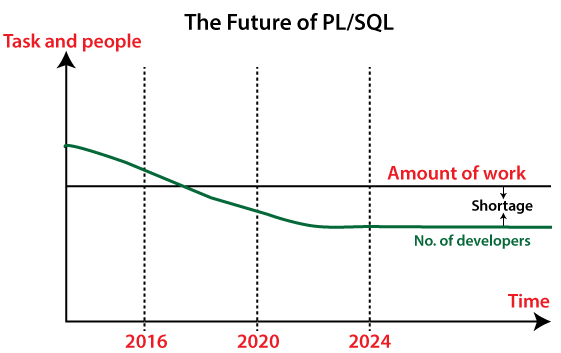PL/SQL Introduction
PL/SQL, also known as “Procedural Language extensions to the Structured Query Language.” As you can guess from the name PL / SQL, it is an extension of SQL ( structured query language ). SQL is one of the most used database languages to update and modify a relational database management system (RDBMS). Before going in depth understanding of PL/SQL, lets first understand the following tems:
SQL (STRUCTURED QUERY LANGUAGE) -It is an open-source relational database manipulative language with a similar syntax like PL / SQL, and is used to update and manipulate data in a database table. In the later chapters of this course, we will even link PL / SQL with Oracle databases.
RDBMS– Relational database management system refers to a system used to store data in a structured format, i.e., in an organised manner using tables, rows, and columns, making it more reliable and easy to locate small details. The term relational refers to the interrelated elements.
ORACLE corporation – An American multinational company established by Larry Ellison, which deals in database technologies, cloud storage systems etc., along with the softwares. They also build tools and languages to modify and manipulate databases.
Some keypoints for PL/SQL are:
- PL/SQL was developed by ORACLE corporation in late 1980s to enhance the performance of prior running language SQL.
- PL/SQL is a simple and straight forward language to easily work with. It is a highly structured language that provides a much better comprehensive solution for programming complex user-defined programs on the Oracle database.
- It provides extra features like loops and conditions. In this version, we can declare variables, constants, and functions. It also supports array, provides extra features for error correction/debugging, boosts websites and web-pages, and supports object-oriented programming.
- As compared to different programming languages such as PYTHON, C++, etc., PL/SQL can’t be used to program alone; i.e., it is not a stand-alone programming language. It is an embedded language that can only be executed in the Oracle database and cannot be executed in any system or environment without containing the Oracle database server.
Why PL /SQL?
Now the question arises, why we should use PL/SQL, when we already have SQL to perform database related tasks. So the answer for this question is given in below points:
- At maximum, SQL can be used for operations like getting data from databases, performing some calculations on data, etc. Also, SQL provides us with privileges like DML ( data manipulation language ) and DDL ( data definition language ) operations. But apart from getting data from the database and altering it,
we cannot do anything from this. What if we ever need to change it, trace it, or add it to a file? We can not depend on SQL for the same, therefore we need PL /SQL for our help.
- PL / SQL is designed to handle complex logical and control statements, and handles SQL logs like security, debugging, and constraints. It is much faster than others in its prospect, and PL / SQL is created only for data manipulation, and that’s only for oracle databases. It also includes some properties like less network loss and bulk insertion, which enhances its speed. Therefore it is more powerful than others.
Features Of PL /SQL
- PL / SQL is a simple and straight forward language to easily work with, and is a highly structured language that provides much better comprehensive solutions for programming complex user-defined programs on Oracle database.
- Provides extra features for error correction /debugging, making it much faster and better for users to easily develop and debug complex programming structures, making it a user-friendly language.
- Gives a boost to web development and webpages, as most of the website contains SQL as their database to manage and store data, and being an extension, PL / SQL works greatly with web servers.
- Supports object-oriented programming, i.e., it works on the concept of objects rather than working on the concept of logic and functions.
- It supports all 4 basic pillars of object-oriented programming: polymorphism, encapsulation, inheritance, and abstraction.
- Not only PL / SQL is a programming language, but it can also transform, update or add any query data in a database.
- Programs designed by PL / SQL are portable and can be easily accessed, compiled, and run with any of the Oracle databases.
- Earlier in SQL we were only able to work with queries and can only manipulate existing data or creates table but with PL / SQL we can easily creates user defined functions that can support features like arrays,variables and constants
Advantages Of PL/ SQL
- PL / SQL provides a much better comprehensive solution for programming complex user-defined programs on Oracle database, and supports both dynamic SQL ,which provides DLL ( data definition language ), i.e., modification in database add, update, remove etc., and static SQL which provides DML ( data manipulation language ) used for inserting, creating tables through block features of PL / SQL.
- PL/SQL is a versatile language and lets us use all SQL data manipulation, cursor control, and transaction control statements, and all functions, operators, present in SQL.
- PL/SQL fully supports SQL data types ,we dont have to convert SQL datatypes to PL / SQL. For example, if PL/SQL takes a value from a column of the SQL with data type VARCHAR2, PL/SQL can store the variable with same data type of VARCHAR2.
- When we directly add SQL statement directly in PL/SQL, then the compiler turns the variables into bind variables. Due to the bind feature Oracle Database can reuse these SQL statements each time the same code runs, which improves performance.
- Due to the advanced features of PL / SQL, it can directly send multiple statements or complete blocks of statements to the database simultaneously, making the language much faster and time efficient and reducing network traffic, which improves program performance.
Disadvantages Of PL/ SQL
There aren’t many disadvantages working on the PL / SQL, if we are working with the Oracle database. Some main disadvantages are given below:
- Since PL / SQL is proprietary or owned by Oracle, which implies if we ever wanted to switch our database provider, it becomes mandatory to rewrite all codes or programs according to that database provider.
- One of the major drawsback of PL / SQL is that it is constructed for database information manipulation like update, delete, etc., not communicating with the user or processing file operations. They provide very few support for input/output operations while reading/writing files.
- PL / SQL is not a display language, and we cannot create any visual things with PL/SQL.
PL/SQL In 2020
As we are already aware of the fact that PL / SQL is an Oracle technology and is used in Oracle databases, which means, PL / SQL won’t outdate that easily until Oracle introduces a new technology to work with data base with better platform. However, the PL / SQL industry is not growing nowadays, but still, most enterprises work on oracle and will hopefully never stop using the oracle database. There will always be a need for a high performance block processing for which PL / SQL will always play a key role.
- Is it good to study PL/SQL in 2020?
Due to the increased trends of modern programming languages like PYTHON, JAVA and introduction of new technologies like MACHINE LEARNING and ARTIFICIAL INTELLIGENCE, there has been found a rapid decline in the people who are skilled PL / SQL users. Still, the demand for PL / SQL is the same since past years. Therefore, it will give you an upper hand in your career. Due to this inverse relation between jobs and less skilled people, a young PL / SQL developer may get some good chances for landing a high paid job.
However, due to the rapid decline in experienced programming professionals of PL / SQL, these individuals’ salaries may show a gradual incline in the period between 2020 – 2024. due to the scarcity of programmers, PL / SQL has the potential to become a highly–paid programming language like COBOL is nowadays. Once you become an experienced PL / SQL programmer and found the right institution to work with, you will become increasingly difficult to replace.

PL/SQL History
Oracle Corporation developed a procedural extension know as PL / SQL ( procedural language for structured query language ) to cope with Oracle relational databases and SQL.
- Version – 6: PL / SQL is programmed with Oracle Databases
- Version – 7: PL / SQL added triggers , functions , packages etc.
- Version – 9 . 7: PL / SQL is programmed with Times TEN in-memory Database.
- Version – 11 . 2 . 1: PL / SQL is programmed with IBM DB 2 Data base.
- Version – 8 onwards: included object-oriented programing options.
- And with every upcoming update, PL / SQL continues updating like conditions, loops, declaring constants and variables, procedure and functions, and modern function, including run-time errors.
Audience
PL / SQL is procedural programming and an extension of SQL; therefore, anyone who has an interest in databases and has prior knowledge of MYSQL can easily understand and master this language. Apart from professionals, anyone with basic knowledge of computers can easily start with this course, and at the end of this tutorial you will find yourself in good terms with this programming language.
Prerequisites
Before going for PL / SQL, users must understand computer programming terminologies and SQL ( structured query language ) and know something about databases, source codes, etc. Thebasic logic of computer programming will provide an upper hand. Entry controlled and exit controlled loop, IF, and ELSE, Strings, Flow of control, Data manipulation, etc., will provide an upper hand.
Problems
We assure you that you will not find any difficulty while learning our PL / SQL tutorial. But if there is any mistake, kindly post the problem in the contact form.


